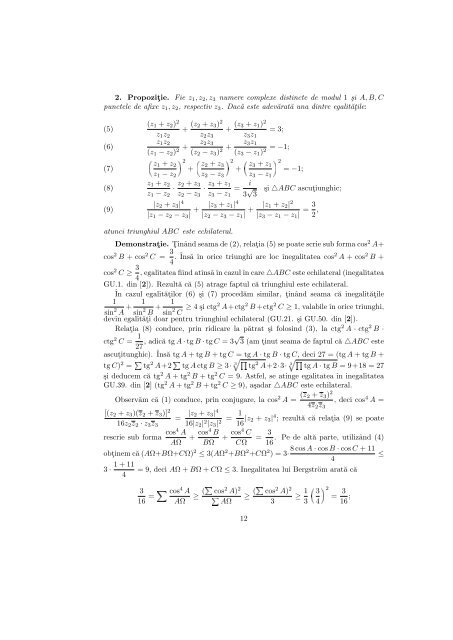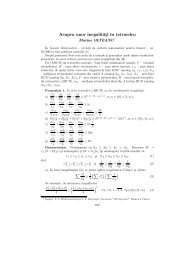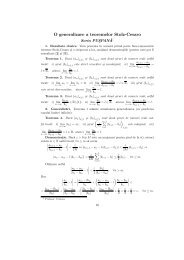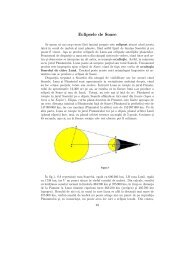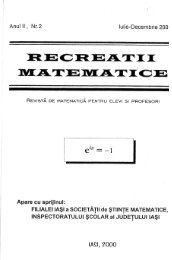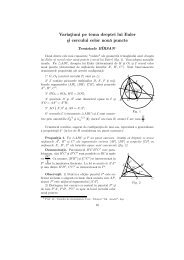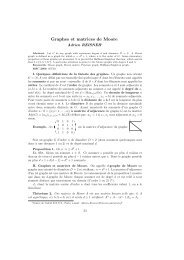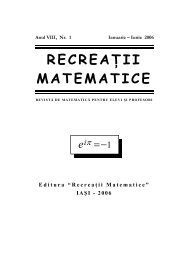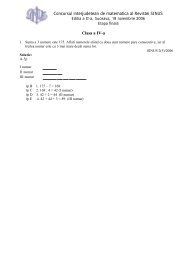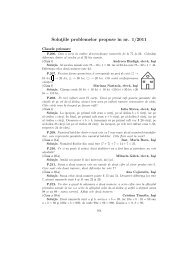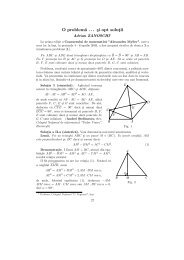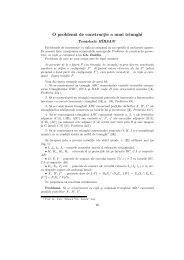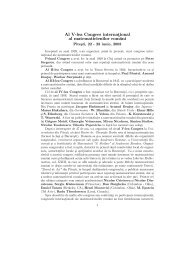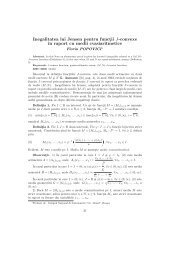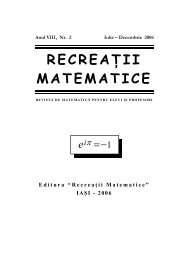2. Propoziţie. Fie z 1 , z 2 , z 3 numere complexe distincte de modul 1 şi A, B, Cpunctele de afixe z 1 , z 2 , respectiv z 3 . Dacă este adevărată una dintre egalităţile:(z 1 + z 2 ) 2+ (z 2 + z 3 ) 2+ (z 3 + z 1 ) 2(5)= 3;z 1 z 2 z 2 z 3 z 3 z 1 (6) z 1 z 2(z 1 − z 2 ) 2 + z 2 z 3(z 2 − z 3 ) 2 + z 3 z 1(z 3 − z 1 ) 2 = −1;z 1 + z 2+z 1 − z 2‹2z 2 + z 3+z 2 − z 3‹2z 3 + z 1(7)= −1;z 3 − z 1‹2(8) z 1 + z 2· z2 + z 3· z3 + z 1=iz 1 − z 2 z 2 − z 3 z 3 − z 1 3 √ şi △ABC ascuţiunghic;3|z 2 + z 3 | 4|z 1 − z 2 − z 3 | + |z 3 + z 1 | 4|z 2 − z 3 − z 1 | + |z 1 + z 2 | 2(9)|z 3 − z 1 − z 1 | = 3 2 ,atunci triunghiul ABC este echilateral.Demonstraţie. Ţinând seama de (2), relaţia (5) se poate scrie sub forma cos 2 A+cos 2 B + cos 2 C = 3 4 . Însă în orice triunghi are loc inegalitatea cos2 A + cos 2 B +cos 2 C ≥ 3 , egalitatea fiind atinsă în cazul în care △ABC este echilateral (inegalitatea4GU.1. din [2]). Rezultă că (5) atrage faptul că triunghiul este echilateral.În cazul egalităţilor (6) şi (7) procedăm similar, ţinând seama că inegalităţile1sin 2 A + 1sin 2 B + 1sin 2 C ≥ 4 şi ctg2 A+ctg 2 B +ctg 2 C ≥ 1, valabile în orice triunghi,devin egalităţi doar pentru triunghiul echilateral (GU.21. şi GU.50. din [2]).Relaţia (8) conduce, prin ridicare la pătrat şi folosind (3), la ctg 2 A · ctg 2 B ·ctg 2 C = 1 27 , adică tg A · tg B · tg C = 3√ 3 (am ţinut seama de faptul că △ABC esteascuţitunghic).Însă tg A + tg B + tg C = tg A · tg B · tg C, deci 27 = (tg A + tg B +tg C) 2 =Ptg 2 A+2Ptg A ctg B ≥ 3· 3ÈQtg 2 A+2·3· 3ÈQtg A · tg B = 9+18 = 27şi deducem că tg 2 A + tg 2 B + tg 2 C = 9. Astfel, se atinge egalitatea în inegalitateaGU.39. din [2] (tg 2 A + tg 2 B + tg 2 C ≥ 9), aşadar △ABC este echilateral.Observăm că (1) conduce, prin conjugare, la cos 2 A = (z 2 + z 3 ) 2, deci cos 4 A =4z 2 z 3[(z 2 + z 3 )(z 2 + z 3 )] 2= |z 2 + z 3 | 416z 2 z 2 · z 3 z 3 16|z 2 | 2 |z 3 | 2 = 1 16 |z 2 + z 3 | 4 ; rezultă că relaţia (9) se poaterescrie sub forma cos4 AAΩ+ cos4 BBΩobţinem că (AΩ+BΩ+CΩ) 2 ≤ 3(AΩ 2 +BΩ 2 +CΩ 2 ) = 3·3 · 1 + 114+ cos4 CCΩ = 3 . Pe de altă parte, utilizând (4)16 8 cos A · cos B · cos C + 11≤4= 9, deci AΩ + BΩ + CΩ ≤ 3. Inegalitatea lui Bergström arată că3=Xcos4 A16 AΩ ≥ (Pcos2 A)PAΩ2≥ (Pcos2 A) 2≥ 1 3 33=4‹23 16 ;12
ne-am folosit şi de inegalitatea cos 2 A + cos 2 B + cos 2 C ≥ 3 , amintită deja la (5).4Cum toate inegalităţile se transformă în egalităţi, rezultă că △ABC este echilateral.3. Propoziţie. Fie z 1 , z 2 , z 3 numere complexe distincte de modul 1 şi A, B, Cpunctele de afixe z 1 , z 2 , respectiv z 3 . Dacă este adevărată una dintre egalităţile:(10)(11)(12)z 1 + z 2+ z 2 + z 3+ z 3 + z 1= −2;z 3 z 1 z 2|z 1 + z 2 | 2 + |z 2 + z 3 | 2 + |z 3 + z 1 | 2 = 4|z 1 + z 2 + z 3 | 2 ;|z 1 − z 2 − z 3 | 2 + |z 2 − z 3 − z 1 | 2 + |z 3 − z 1 − z 2 | 2 = 11,atunci triunghiul ABC este dreptunghic.Demonstraţie. Relaţia (10) arată că −2 =Pz 1 + z 2z 3=Pz 3 (z 1 + z 2 ) =P(z 2 z 3 + z 2 z 3 ) =P(4 cos 2 A − 2), deci cos 2 A + cos 2 B + cos 2 C = 1. Rezultă că1 − 2 cos A · cos B · cos C = 1, adică cos A · cos B · cos C = 0 şi de aici urmează că△ABC este dreptunghic.Egalitatea (11) se rescrie sub forma 4 cos 2 A + 4 cos 2 B + 4 cos 2 C = 4OH 2 , deunde 1 − 2 cos A · cos B · cos C = 1 − 8 cos A · cos B · cos C, deci cos A · cos B · cos C = 0şi din nou obţinem că △ABC este dreptunghic.Din (12) rezultă, ţinând seama de (4), că 11 = 4(AΩ 2 +BΩ 2 +CΩ 2 ) = 11+8 cos A·cos B · cos C, prin urmare cos A · cos B · cos C = 0, adică △ABC este dreptunghic.Bibliografie1. T. Lalescu – Geometria triunghiului, Editura Tineretului, Bucureşti, 1958.2. I.V. Maftei, P.G. Popescu – Inegalităţi alese în matematică, Editura Niculescu,Bucureşti, 2005.Nichita StănescuAltă matematicăNoi ştim că unu ori unu fac unu,dar un inorog ori o parănu ştim cât face.Ştim că cinci fără patru fac unu,dar un nor fără o corabienu ştim cât face.Ştim, noi ştim că optîmpărţit la opt fac unu,dar un munte împărţit la o caprănu ştim cât face.Ştim că unu plus unu fac doi,dar eu şi cu tine,nu ştim, vai, nu ştim cât facem.Ah, dar o plapumăînmulţită cu un iepureface o roşcovană, desigur,o varză împărţită la un steagfac un porc,un cal fără un tramvaiface un înger,o conopidă plus un ou,face un astragal...Numai tu şi cu mineînmulţiţi şi împărţiţiadunaţi şi scăzuţirămânem aceiaşi...Pieri din mintea mea!Revino-mi în inimă!13
- Page 1 and 2: Anul XIV, Nr. 1Ianuarie - Iunie 201
- Page 3: Anul XIV, Nr. 1 Ianuarie - Iunie 20
- Page 6 and 7: dar s-a mirat că memoriul său n-a
- Page 8 and 9: domenii noi şi actuale, prof. Adol
- Page 10 and 11: Exerciţiul 1. Fie b ≥ 2 un numă
- Page 13 and 14: · · · + a s+t−1 − a s+t , q
- Page 15: Aplicaţii ale numerelor complexeî
- Page 19 and 20: Teorema 3. Fie ρ ∈ [0, ∞]. Atu
- Page 21 and 22: Problema 8. Confirmaţi sau infirma
- Page 23 and 24: Remarca 2. Deşi Goehl, în [2], pr
- Page 25 and 26: Lema 2. În triunghiul OHI are loc
- Page 27 and 28: Se ştie că punctul I aparţine dr
- Page 29 and 30: Asupra unei probleme de extremRadu
- Page 31 and 32: Une classe spéciale de matrices ca
- Page 33 and 34: 4. Un exemple de B-matrice de M 4 (
- Page 35 and 36: toutes ses valeurs propres sont nul
- Page 37 and 38: Clasa a IX-a1. Să se determine cel
- Page 39 and 40: corespunzătoare. În acest caz, pu
- Page 41 and 42: Vom exprima această condiţie în
- Page 43 and 44: Pentru x = π 2 ∈ (−π, π), av
- Page 45 and 46: Colegiul Naţional ,,Mihai Eminescu
- Page 47 and 48: condus şcoala până în septembri
- Page 49 and 50: Concursul ,,Recreaţii Matematice
- Page 51 and 52: Concursul interjudeţean ,,Speranţ
- Page 53 and 54: Soluţiile problemelor propuse în
- Page 55 and 56: Soluţia 2 (Cătălin Gulin, elev,
- Page 57 and 58: faţă de C şi mediana din B taie
- Page 59 and 60: Soluţie. Folosind faptul că patru
- Page 61 and 62: IX.122. Fie a, b, c ∈ R cu b ≥
- Page 63 and 64: astfel încât u 2 = z 2 + 4 . Cum
- Page 65 and 66: p ∈ N ∩ G, atunci p ∈ H, prin
- Page 67 and 68:
(6, 1, 2). Analog, când c = 1 vom
- Page 69 and 70:
Soluţie. Fie P un semiplan limitat
- Page 71 and 72:
Soluţia 1. Raportăm planul la un
- Page 73 and 74:
a) Fie n ∈ N ∗ care verifică {
- Page 75 and 76:
P.234. Aflaţi numerele naturale a
- Page 77 and 78:
VII.147. Trapezul dreptunghic ABCD
- Page 79 and 80:
XI.127. Fie (x n ) n∈N ∗ un şi
- Page 81 and 82:
a) RQ ⊥ AD şi RQ = AD;b) RE = F
- Page 83 and 84:
|{z}n timeG220. Determine the digit
- Page 85 and 86:
Pagina rezolvitorilorCRAIOVAColegiu
- Page 87 and 88:
RecenzieD. Brânzei şi Al. Negresc
- Page 89 and 90:
Revista semestrială RECREAŢII MAT


